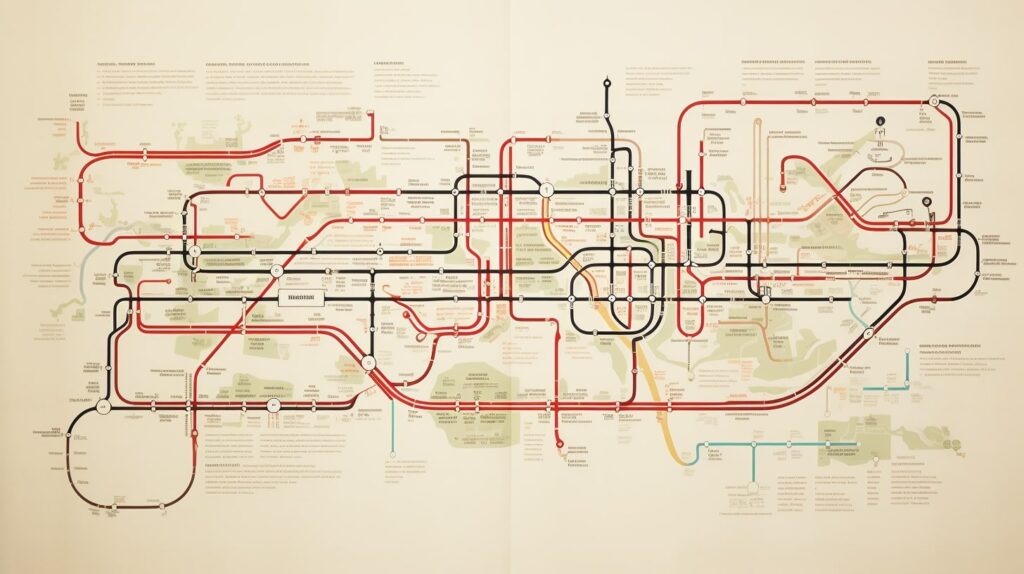So this is about blog ads and this post might disappoint you. It’s not that we don’t like blog ads. Ad revenue is great!
When it’s coming in.
However, it’s not our favorite way for you to learn how to make a living blogging.
And second of all, if you are hoping to get ads up on your site, it can be a long road in today’s blogging world. If you find yourself wondering how to make money blogging then the answer is kind of like this:
One time I went on a 12-hour bus trip across Spain. We stopped twice.
Working to get ads up on your blog will feel even longer than that bus trip. And there’s no stopping.
It’s so easy to get caught up in the idea that as long as you continue to create content and get traffic to it, you’ll be fine because the ad revenue will come and then be consistent.
The problem is that you don’t control the actual revenue.
You don’t control how much the advertising companies are paying to be seen on your blog and you don’t control how much the ad networks take.
You also don’t control your traffic.
There are so many variables out of your control when it comes to ad revenue which means it’s always a good time to focus on the revenue streams that you can control.
While this guide is focused on how to increase your ad revenue, I also have another guide to show you how to increase other revenue streams.
But for now, let’s focus on those ads.

How to Increase Your Ad Revenue
There are two ways that you can increase your ad revenue:
- More pageviews
- Higher RPM
There are things that you can do to improve both, but RPM is always going to be the hardest because there are simply too many variables that go into it.
One thing that I will warn you about, and it’s why I didn’t mention it above, is adding more ads.
It’s natural to think that if you add more ads you’ll raise your total ad revenue but there are a couple of factors that you have to keep in mind.
Adding More Ads, Think About It First
The user experience is of the utmost importance when it comes to ad revenue because a better user experience gives you a better shot of ranking higher in Google and ranking higher in Google means more traffic and more search engine (organic) traffic leads to higher RPMs.
So while adding more ads can be beneficial in the short term, it can harm you in the long term.
Another thing to consider with the user experience is time on-page. If people feel like they’ve entered an ad graveyard, how likely are they to stick around on your page?
Shorter time on-page leads to lower RPMs. Higher time on-page leads to higher RPMs.
With all of that in mind let’s see how you can go about increasing pageviews.

Increasing Pageviews
Increasing pageviews isn’t only done by bringing more people to your site. You can obviously bump up your pageviews by bringing more people onto your site, but only focusing on that strategy means you have to work on bringing more and more people to your site every single day.
What about getting the people that are on your site to visit more pages?
This is what the larger media sites focus on. They find ways to “trap” you in their sites.
If you go there you might be lost down a rabbit hole forever because they find ways to lead you around.
Obviously, your blog is a different beast, but that doesn’t mean you can’t find ways to keep people moving along your site.
So the question is how can you do that in a way that improves the user experience for the reader?
Mapping the Journey
I’m sure you’ve seen blogs where there is a section at the end of the post for related posts. It’s a solid idea that is usually poorly executed.
What I mean by this is that if I visit a blog post that talks about how to use manual mode on a camera, then that means I’m looking to do more advanced stuff with my camera, right?
So if that blog post suggests that I look at The Beginner’s Guide to Photography then I probably wouldn’t be intrigued enough to click over to read it.
What you need to understand is the context of the reader’s visit.
They’re visiting your blog post to learn something specific. Once they do that what is the next step for them?
We call this mapping their journey. If you can turn your blog into a map for the reader they are more likely to follow it and view more pages.
It also means they stay on your site longer which is a great sign to Google that your content is both relevant and interesting.
Why does that matter?
That can help you move up the rankings in Google which in turn gets you more traffic.
Do you see the cycle here?

SEO and the Long-Tail
Depending on the age of your site SEO might take the time or it might take no time at all.
When you’re looking to make big gains in your traffic it’s very easy to look at the big keywords. What I mean is that if you use a keyword tool then you go looking for big volume keywords.
Those Big Daddy keywords that you think would get you a ton of traffic.
There is nothing wrong with that approach if it works out for you.
The problem, as you know, is that everybody is going after those big-volume keywords.
So what do you do?
Look for longer tail keywords and target them.
Kind of.
What I would do is make sure that each of my posts is targeting a decent-sized keyword (search volume > 1,000) but also ensure that I target a cluster of long-tail keywords.
While this cluster of keywords might not bring in as much traffic as the big volume keyword it’s where you start to make traction with things.
It’s very easy to fall into the trap of targeting a single keyword and putting all of your hopes into that. Any other keywords that you rank for are a bonus.
This is why longer-form content is so valuable. It gives you a lot more opportunities to rank for different keywords.
Too many bloggers fall into the trap of thinking that their readers don’t want to read long content.
That’s wrong.
Their readers don’t want to read long, unhelpful, and boring content. Nobody does.
But if your content is informative and engaging then why wouldn’t they want to stick around?
For example, I didn’t write a simple post on worldbuilding. I created an entire site around the topic of worldbuilding.
Not once did I worry if I was making it too big or adding too much content.
In fact, I thought the opposite.
How could I add even more value and content to it!
The results speak for themselves.

Achieving a Higher RPM
If you don’t know, RPM is a metric that measures how much money you’re making per 1,000 pageviews. Depending on your ad network that might measure per 1,000 sessions.
It really doesn’t matter because you just want the number to be high.
The problem is that RPM is always based on a number of different factors. Some of them include:
- quality of traffic
- time on page
- topic of content
Don’t worry, we will cover each one.

Quality of Traffic
To put it simply organic (traffic from search engines) traffic is more valuable to advertisers than social media traffic.
Why?
Intent.
When someone searches on Google they are looking for something specific. If you’re an advertiser wouldn’t you want to get your product in front of that person to let them know you have the specific solution for them?
Of course!
There is nothing wrong with social media traffic. Many of you reading this will have sites mostly powered through social media.
However, any marketer will tell you that organic traffic is much more beneficial to a business and that’s why you’ll see higher RPMs with it.
Time on Page
We briefly discussed this one in the previous section but why does time on page matter?
It means that people are more likely to see more ads and spend more time getting exposed to the ads on the page.
You can think of it like this.
If a person goes to your blog and visits a page for 5 seconds, should you get credit for every single ad on that page?
Nope because chances are the person didn’t see all of the ads.
If someone stays on a page for 5 minutes, reads all of your content, and is exposed to all of the ads on the page should you get credit for that?
Most definitely.
This is why you have to be careful with opting for more ads.
More ads can ruin the experience and lessen your time on page which therefore will shrink your RPMs.
However, when you provide more value and can lead your reader along your blog then you’ll increase your pageviews, increase your time spent on page, and most importantly, increase your RPMs.
Topic of Content
Unfortunately, you don’t have much control over this one since you write what you write.
I don’t expect many people to turn their Parenting blog into a blog about trading stock options for example.
However, that doesn’t mean you can’t get creative with some posts.
For example, if you believe a post on money (making, saving, budgeting, etc) could provide you with a bit more ad revenue then figure out a way to tie that into your current topics.
Going back to the Parenting blog maybe you could write about how one could save money for the children’s college fund or how to teach your kids personal finance.
Value & User Experience Over Everything
It’s very easy to get lost in the idea that to boost your ad revenue you need to do superficial things like add more ads or trick people into viewing more content.
But businesses (your blog is a business) are rewarded by serving their audience in the best way possible.
Take a step back from your blog and see if you’re really providing great value and a user experience that showcases that value.
If not, then those would be the first things I’d work on.
Once you nail those, then you can go out and find more traffic.
Going Beyond Blog Ads
Look, I enjoy ad revenue as much as the next blogger. You get to sit back and just focus on writing content. But blogging has evolved to the point where relying on ad revenue at all is silly.
However, I also understand that relying on ad revenue alone can be a dangerous game. It’s the main reason why trying to create a successful blog overnight doesn’t work for most people.
Ad revenue doesn’t just appear.
That’s why I love creating my own digital products. It means I have more control over my revenue and I’m not reliant on large amounts of traffic.
You might think that creating a digital product of your own is out of reach but it really isn’t. It doesn’t even have to be a larger product either.
The only thing that you want to make sure about is that it is something that your audience wants.
